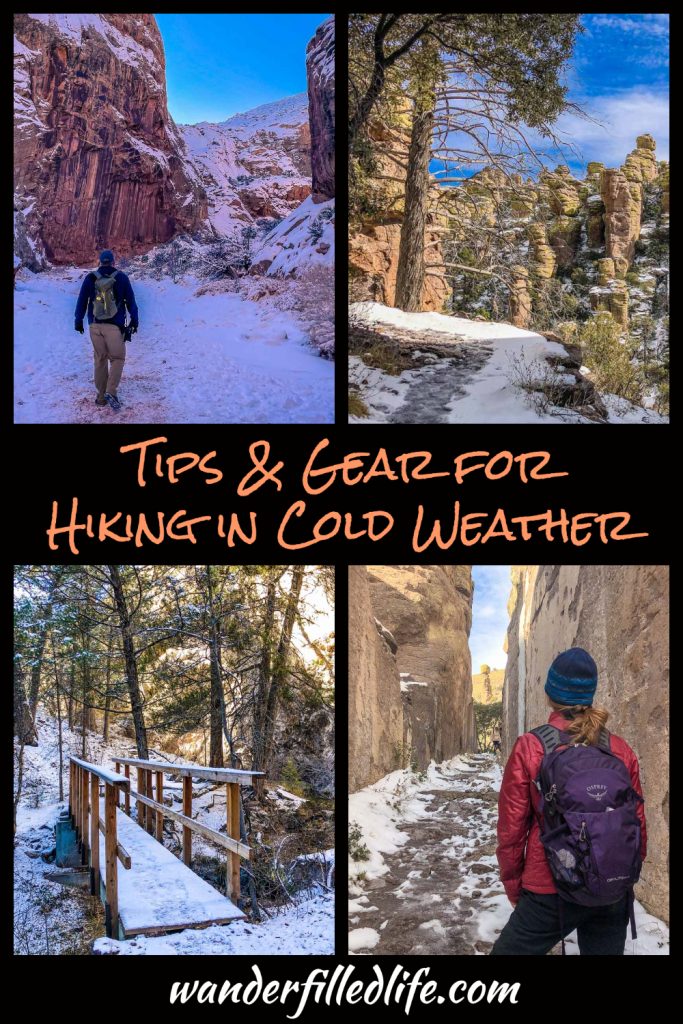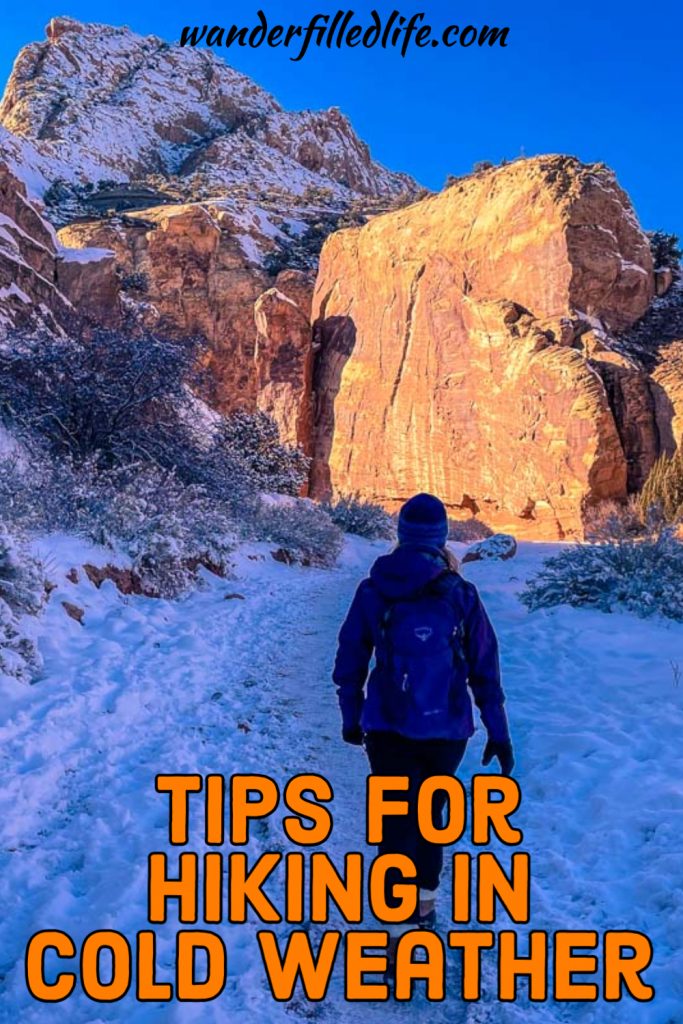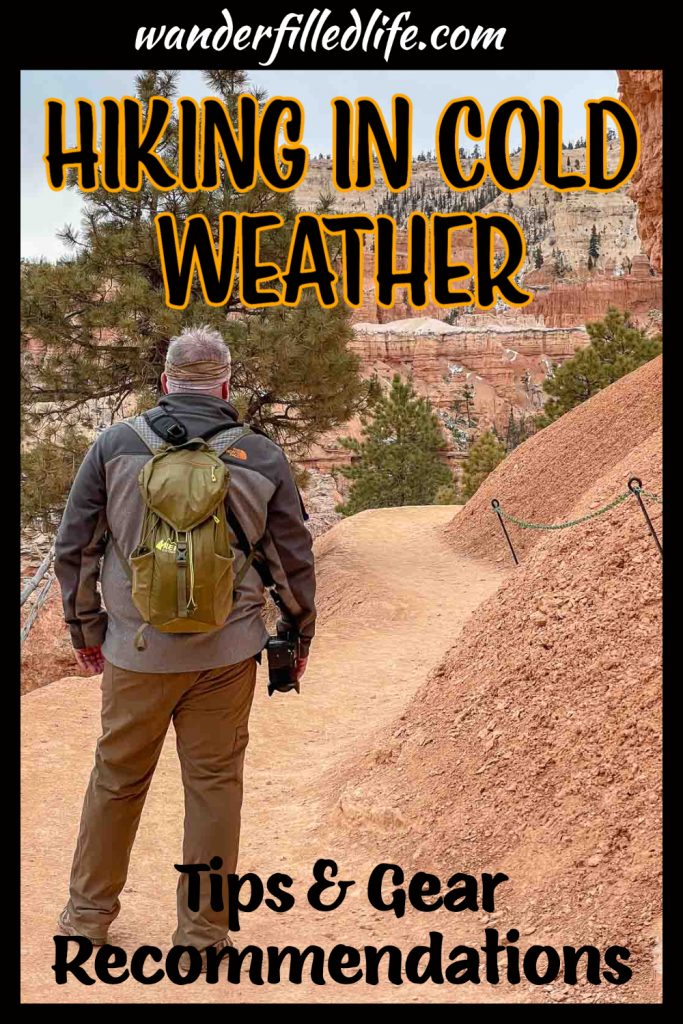Last Updated on February 18, 2024 by Grant
Hiking in cold weather is a different animal than hiking in the summer. In the summer, you need to worry about making sure you have the 10 essentials but you don’t need a ton of gear. Hiking in cold weather, particularly anywhere that gets snowfall, is a bit more hazardous.
Dealing with frigid temperatures out on the trail requires a bit more gear and, honestly, the quality of your gear matters a lot! Wearing solid layers will make sub-freezing temperatures comfy. Wearing poor layers will make the cold uncomfortable at best, dangerous at worst.
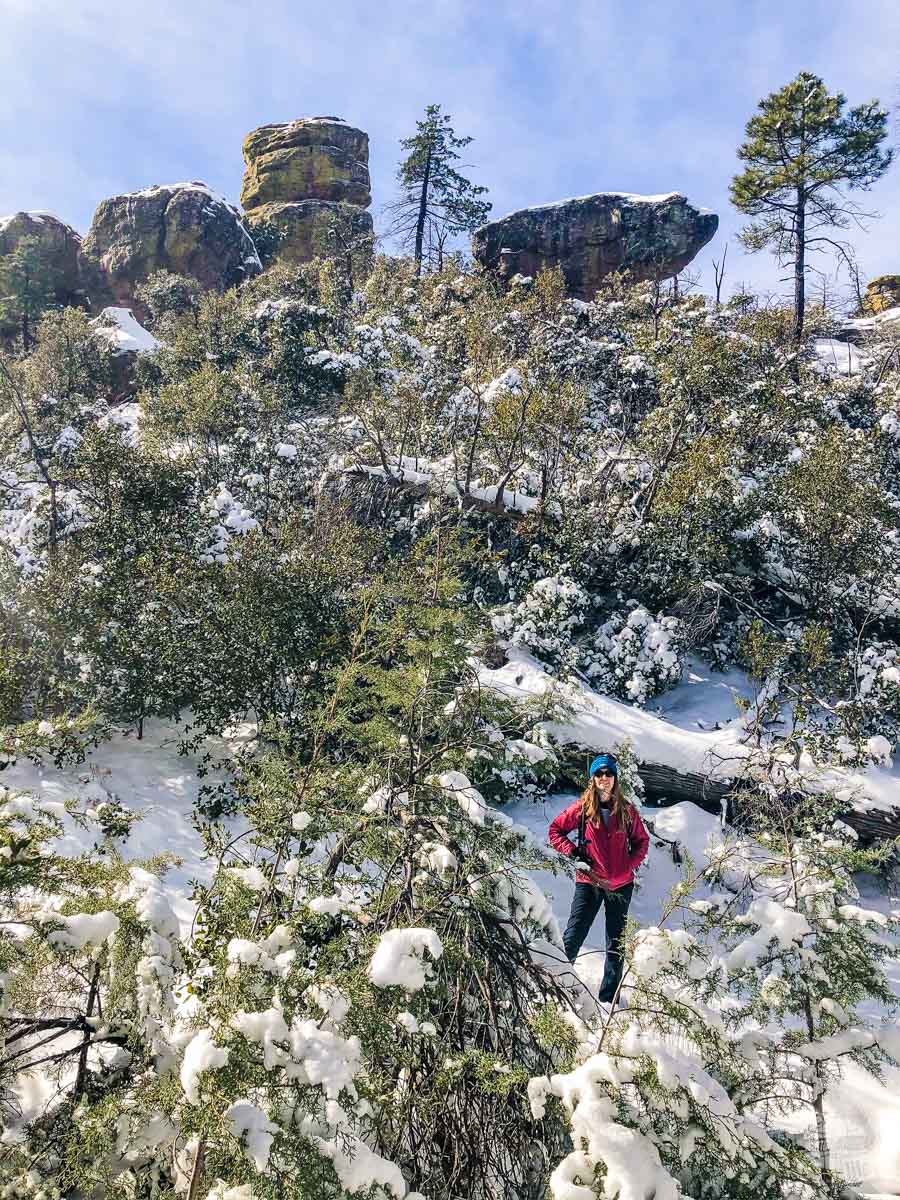
Since we often road trip in the winter, we end up hiking a lot on snow-covered trails in freezing temperatures and we love it. There is something truly exquisite about hiking through a winter wonderland.
(Disclaimer: When we link to places where you can buy our stuff or places we stayed, we are using special codes that earn us commissions on the sales at no additional cost to you. Please see our Review Policy for more information.)
Make Sure You Have the 10 Essentials
When you go hiking in cold weather, having the 10 Essentials with you at all times is even more important. Cold weather makes surviving in the event of an emergency that much more difficult. Cold weather also means you need to make sure you have different gear than you would take with you in other seasons.
At the very least, you should make sure you have an additional mid-layer in your pack. When the sun goes down, temperatures drop considerably and you need to keep your core warm.
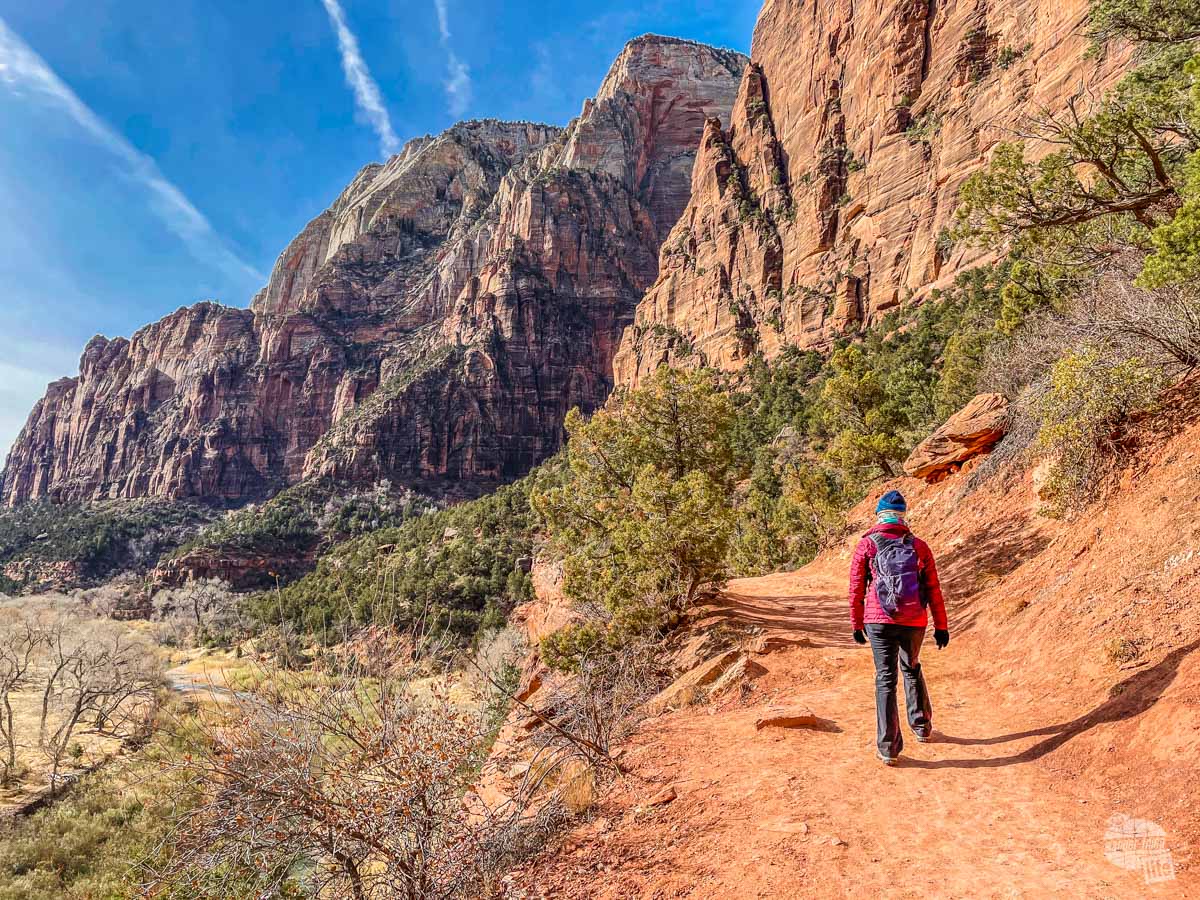
Additionally, building a fire becomes a lot more important and in addition to a fire starter, you really need to bring kindling with you. Being able to start a fire and keep it going can be the difference between life and death.
Read more about our picks for the 10 Essentials here.
While constantly dragging all of that gear with you can seem onerous and unnecessary, especially on shorter hikes, all it takes is one accident that immobilizes you on the trail to make a life-or-death situation.
You Might Need a Bigger Daypack for Hiking in Cold Weather
One aspect about hiking in cold weather that most folks don’t think about it is having enough room in your daypack to stuff in extra layers.
To be honest, the daypacks we use for hiking throughout most of the year are too small to cram our shell layers into if we get too warm. They also get pretty cramped if we take an extra mid-layer.
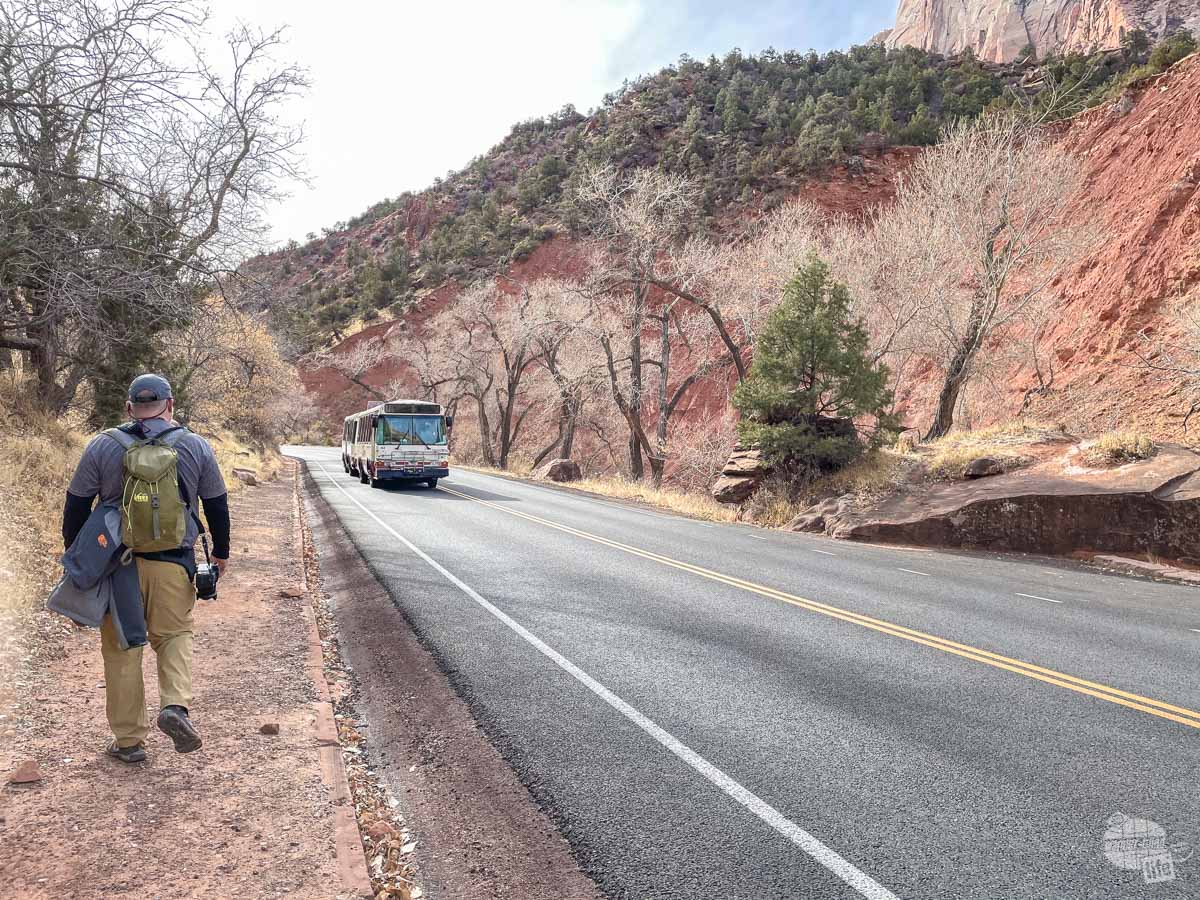
I am not saying you have to go out and buy a new pack just for the winter. That said, if cold-weather hiking is something you plan on doing frequently, you might want to consider something larger for your year-round daypack. I ended up replacing my REI Flash 22 with the REI Trail 25 for exactly this reason. I want to be able to easily stuff my softshell jacket into my daypack.
Read more about our daypacks here.
Be Prepared for Snow-Covered Trails
Aside from the obvious issues of hiking through the snow, a covered trail can actually be a serious issue, especially if you are in open country with little in the way of trail markers.
On busier trails, you can typically count on tracks of other hikers to lead you the right way. But, sometimes, that backfires, as we discovered at Colorado National Monument.
As we hiked out to Devil’s Kitchen, we lost the trail in the rocks. We followed the tracks of other folks and ended up way off the trail. We even pulled out AllTrails and looked at the map with GPS enabled. No luck as to where we were supposed to go.
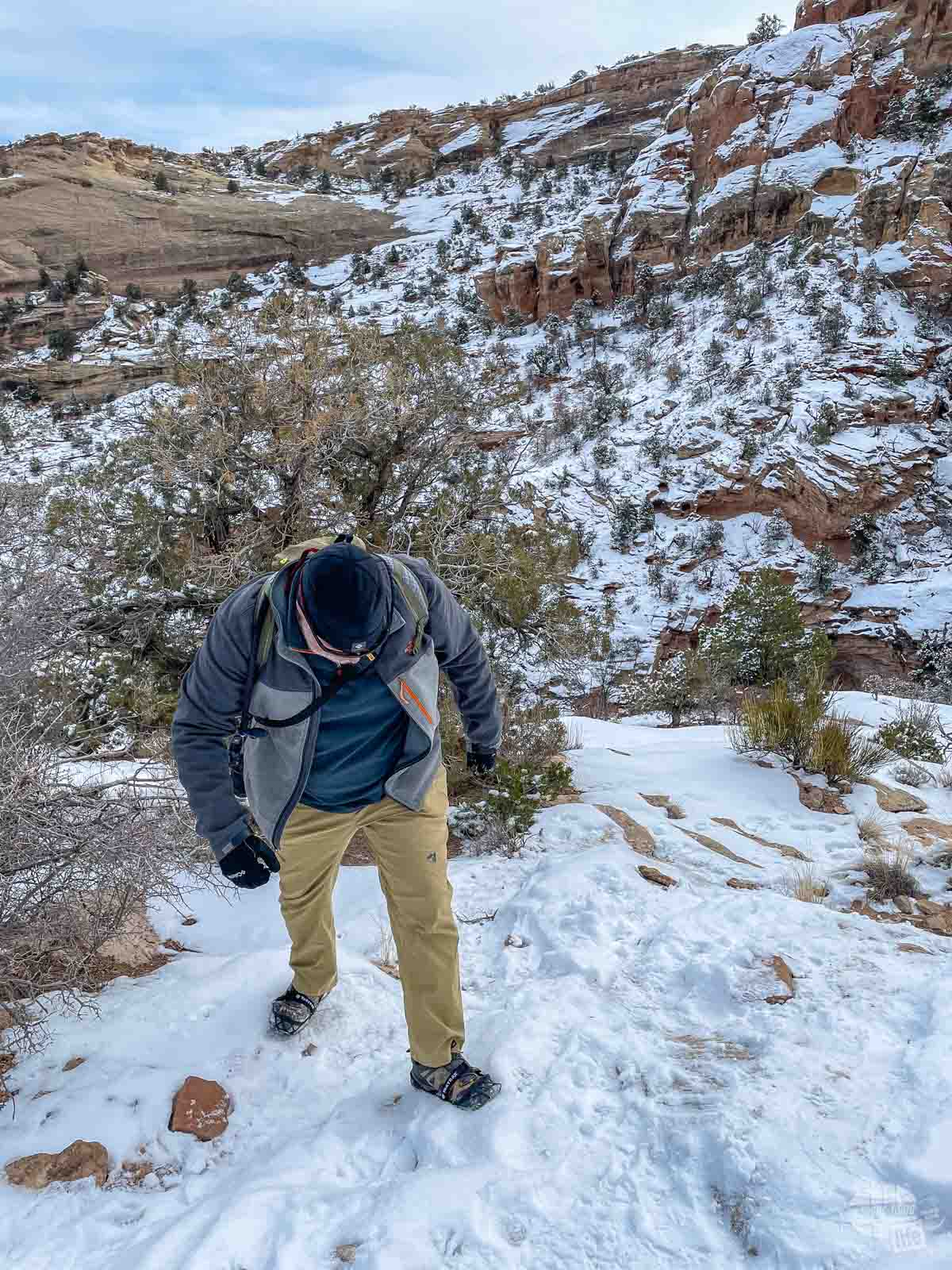
After wandering around a bit, we managed to figure out we had walked past the formation and went to check it out. We were never lost but I can certainly see how easily you can lose a trail when it is covered by the snow.
Another aspect of hiking in the snow is the lack of traction. Especially on rocky trails, snow and ice can make for some seriously slick conditions. Indeed, I slipped on some rock stairs in Arches National Park on our winter trip out there and was honestly surprised I did not break a bone I hit so hard. Having the proper gear, head to toe, for hiking in the snow really is important!
Gear Up for Hiking in Cold Weather
So, let’s talk about the gear you need for a good hike in the winter. First and foremost, let’s talk about the first rule when picking gear for spending extended time in the cold: dress in layers.
That simple tip will allow you to manage your body temperature as you get warmer, both as you hike and as air temperature warms on a sunny day. As a general rule, you should start with a base layer that both keeps you warm and wicks moisture away from your body.
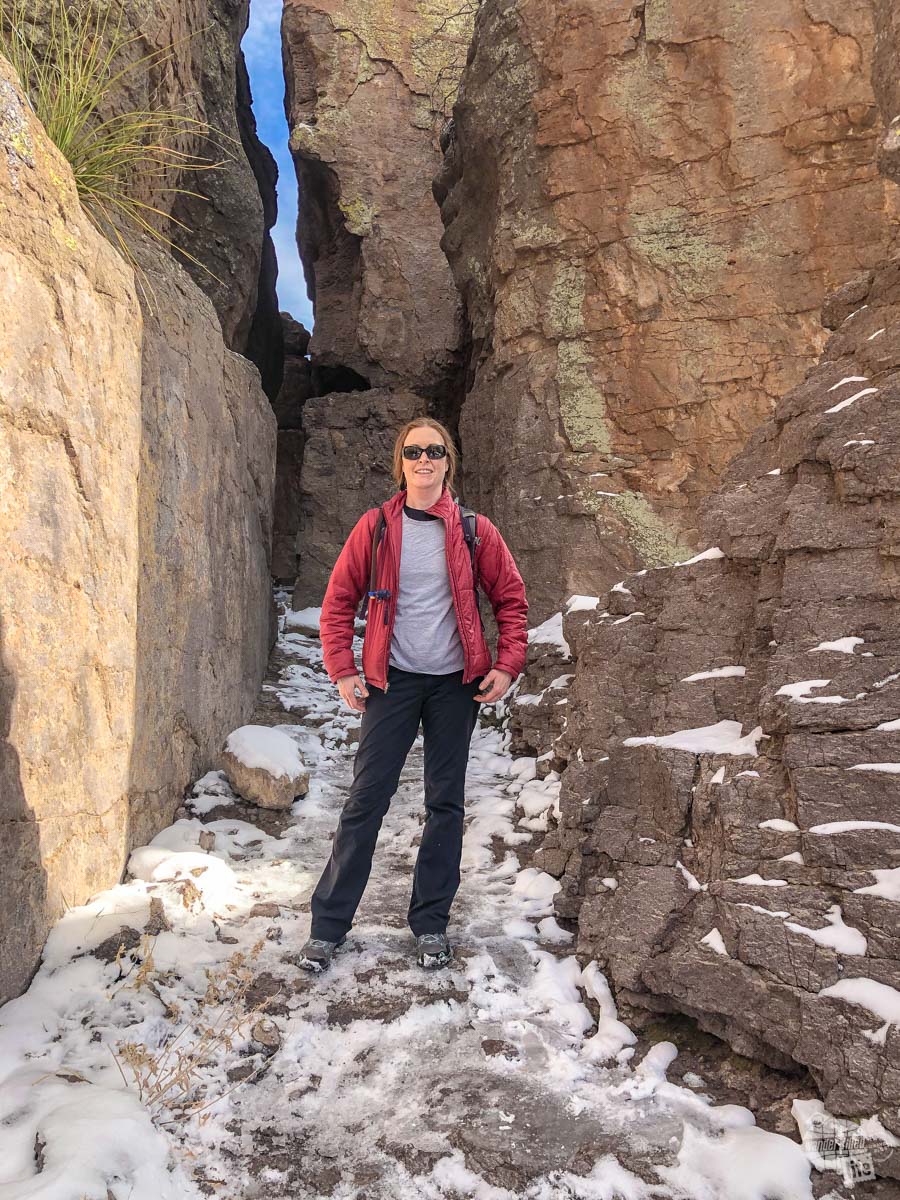
From there, add a solid mid-layer. A good mid-layer, like a fleece pullover, will trap air near your body, allowing your body to heat up the trapped air. Lastly, you want an outer shell layer that will stop wind and moisture.
In terms of fabric, there is one cardinal rule: avoid cotton! When cotton gets wet, it stays wet and will cling to your skin, robbing your body of heat.
We wear either synthetics, like polyester and nylon, or wool. Both wick moisture away from your skin and keep you warm even if you get the fabric wet. This is essential to both staying comfortable on the trail and your survival if you have an issue on the trail.
Base Layers
We have an assortment of base layers we wear out on the trail. We have some lightweight Polartec layers that are great for moderately cold temperatures and they work fine. Snowmobiling in Yellowstone National Park many years ago resulted in us getting some heavy Polartec base layers.
But ounce for ounce, the best base layers we own are the Omni-Heat layers from Columbia. These layers are perfect for hiking in really cold temperatures. These lightweight layers reflect a ton of heat and wick moisture like a champ.
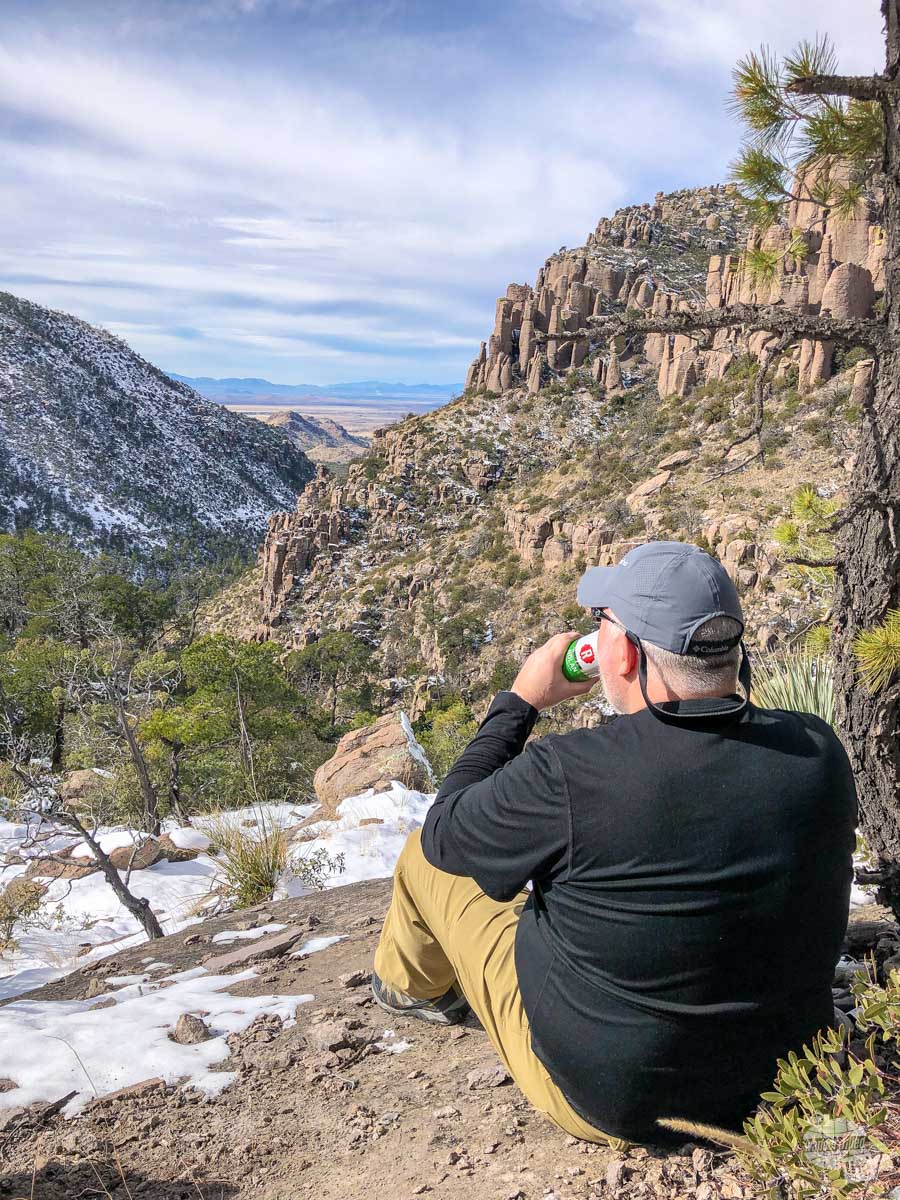
Honestly, the biggest complaint we have about the Omni-Heat base layers is they can be too warm. I find if the temperature starts to warm up, that I end up shedding my mid-layer early and just wearing the base layer.
Mid Layers
The purpose of a mid-layer is to create a space near your body that will trap air. That’s the way insulation works. It creates small pockets that trap air and your body heats up the air thus keeping you warm.
I end up wearing a lot of different fleeces. I wear them like many other folks wear a sweater. There are several different weights of fleece to wear in my wardrobe and I choose the one for the hike based upon the temperatures I can expect.
Because we live right down the road from a Columbia Outlet, we end up buying a lot of fleeces from them. We also end up at Eddie Bauer and REI regularly. They all make good fleeces.
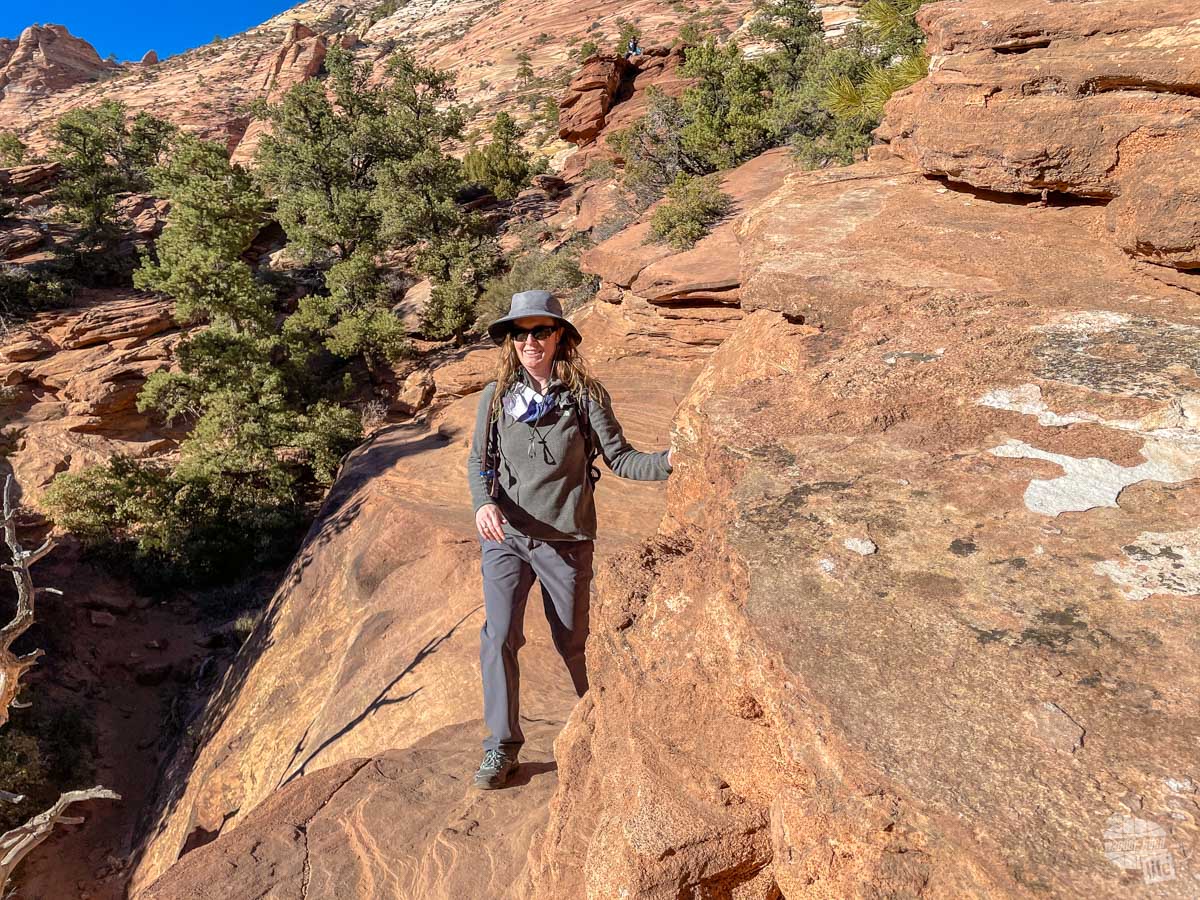
Bonnie really likes vests as a mid-layer and tends to wear them quite a bit. She likes not having sleeves because she does not like to roll up her sleeves to cool down when it gets warmer. Vests are also a good option when temperatures are cold but not freezing.
Shell Layer
For a shell or outer layer, you really want something that will both keep heat in and keep the elements out. It should keep the wind out at a minimum and I recommend it keeping rain and snow out as well.
That’s one reason I really like softshells. I find a softshell jacket will handle everything needed for a hike and work well as a general winter jacket.
I really love my The North Face Apex Bionic softshell jacket. This jacket has been with me for nearly a decade and it kicks butt! It blocks the wind, shrugs snow off and even handles a good cold rain.
It breaths like a champ and is great for a hike.
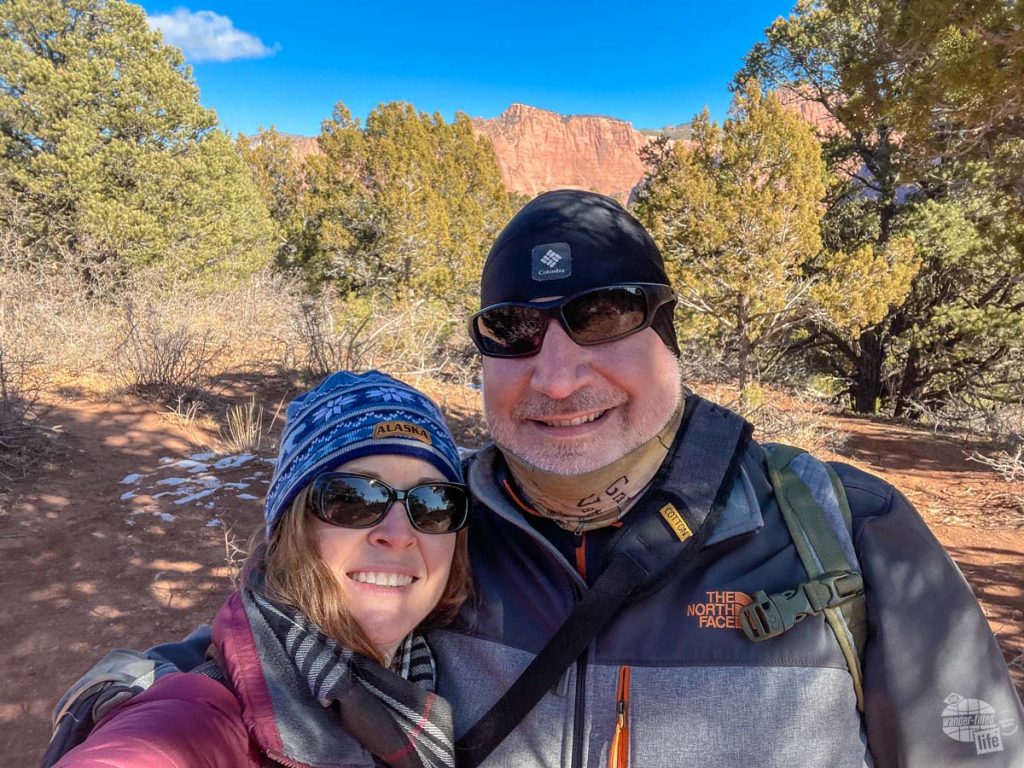
Bonnie really likes her Columbia Whirlibird Interchange Jacket. What makes the Whirlibird jacket so useful is its versatility. It has a zip-in Omni Heat fleece jacket that functions very well as a mid layer. The outer shell has a zip-off hood and is water- and wind-proof.
It makes for a versatile coat for winter hiking since you can choose to wear the shell by itself, with the liner jacket or just the liner jacket, depending on what you need for the weather.
Pants for Hiking in Cold Weather
Like the shell layer, a good set of pants for winter hiking should keep the wind and water out. For hiking, we will wear a base layer under our pants but rarely wear any sort of mid-layer. For the most part, if you are hiking, your legs will keep themselves warm.
Most of the time, I end up wearing Eddie Bauer Guide Pro/Rainier pants. These lightweight nylon pants handle moisture just fine. It is not the best at stopping wind but when combined with a base layer, it keeps me perfectly warm.
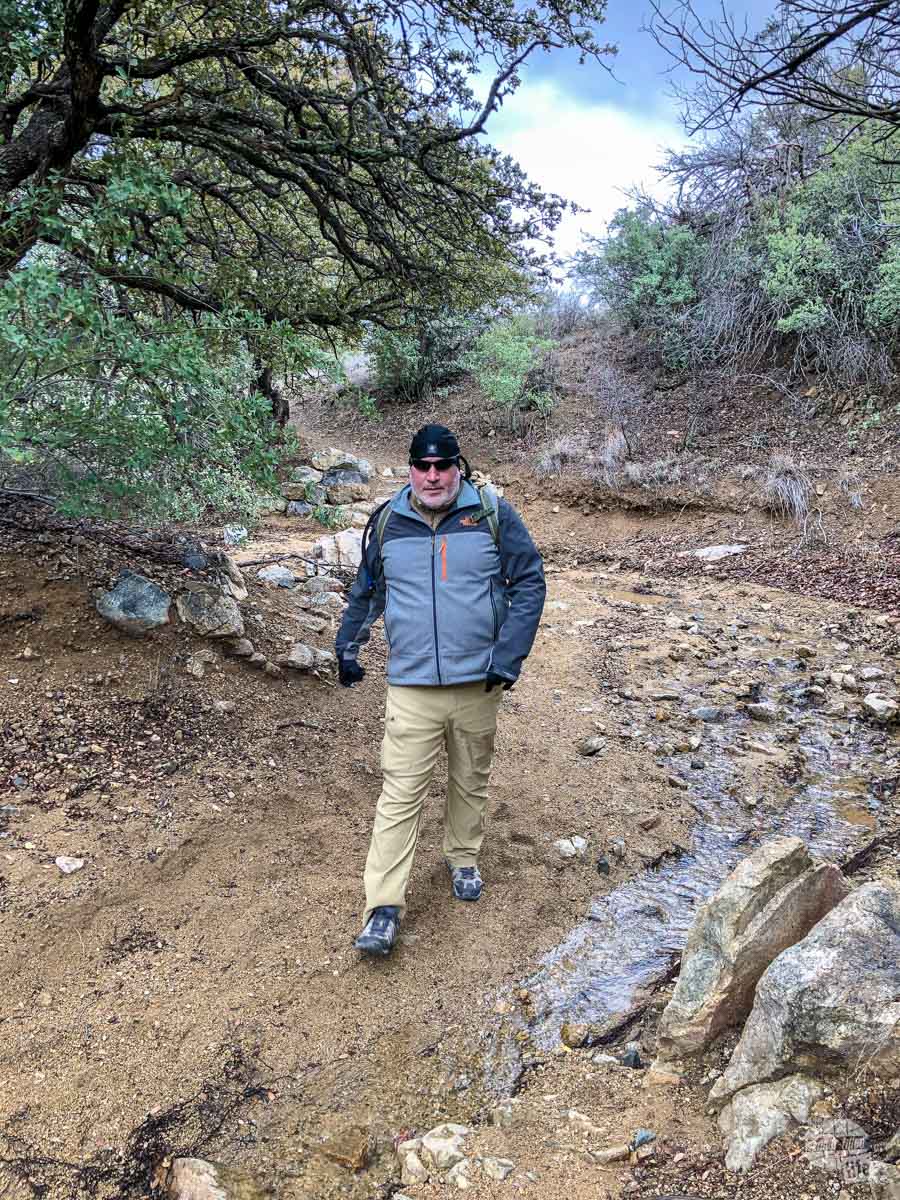
The folks at KUHL sent me a pair of their Klash pants to try out on the trail and I must say I really like them for cold, windy days. They stop the wind much better than the Eddie Bauer pants and the fabric is a lot more durable.
Like the Eddie Bauer pants, the KUHL pants have several well-thought-out pockets. That said, my biggest grumble is all of the KUHL pockets have zippers. While I love zippers for leg pockets, I am not a fan of zippers on the front pockets. It makes getting my phone out for pictures difficult. Still, the pants are great and will get a lot of use on colder days.
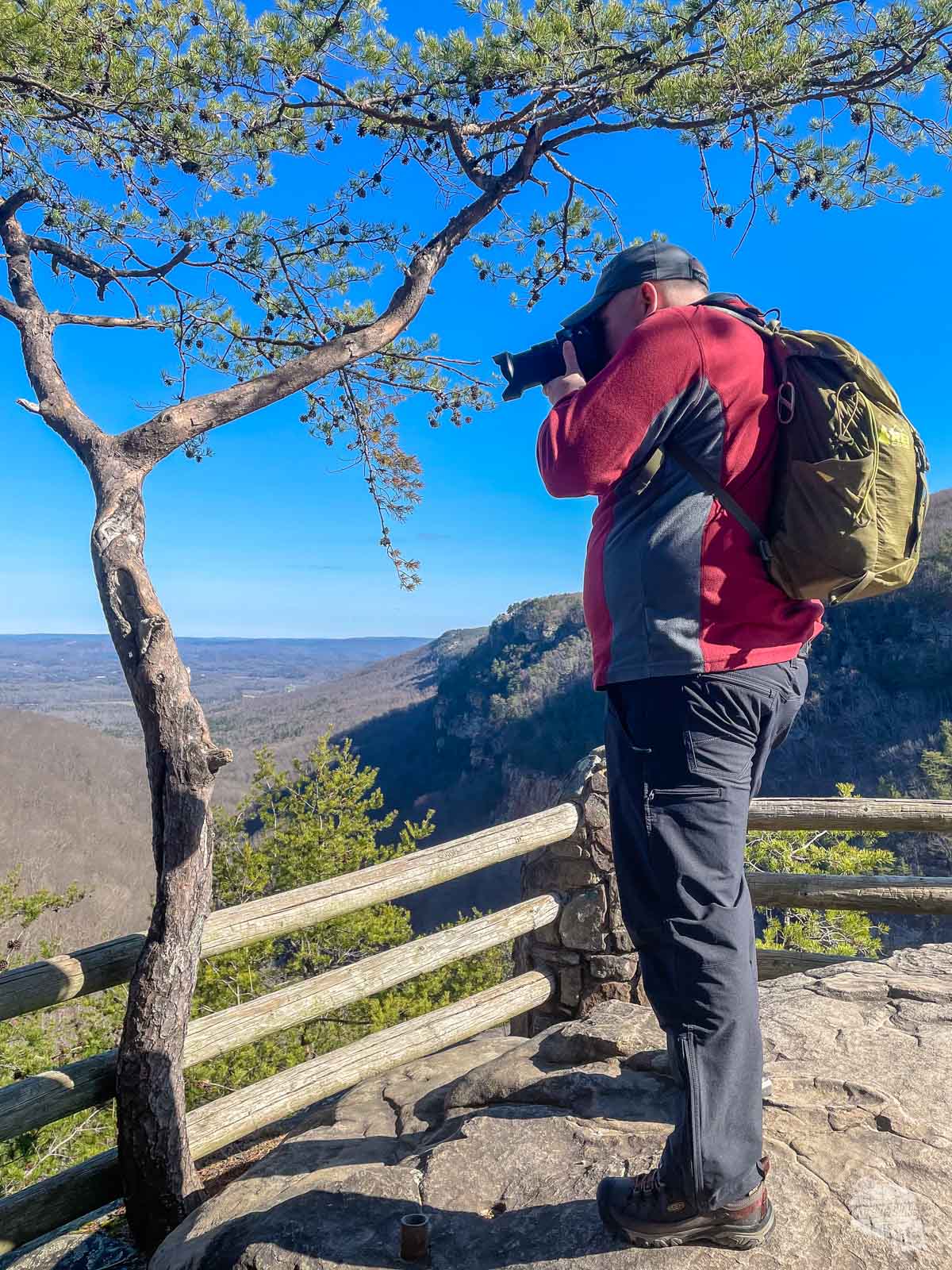
I also have a pair of Mountain Hardwear softshell fleece-lined pants. These pants are great when the temperatures drop below freezing and you are going to be out for a long time. They are comfy and durable but they are very warm.
Bonnie likes her Columbia Saturday Trail pants for most hikes. They keep the wind and water out and are quite comfy. You can easily add a base layer if you need a bit more insulation.
- ADVANCED TECHNOLOGY: Columbia Women’s Saturday Trail Pant features our signature water and stain repellent fabric for protection against harsh stains and liquids and UPF 50 to protect against harmful sun rays.
- HANDY FEATURES: Two side pockets with hook and loop closure and two back pockets are featured to secure your smaller items.
For colder days, she likes these fleece-lined pants from Eddie Bauer. Like the pair I have, they are great but they are really warm, so only wear them on the coldest days.
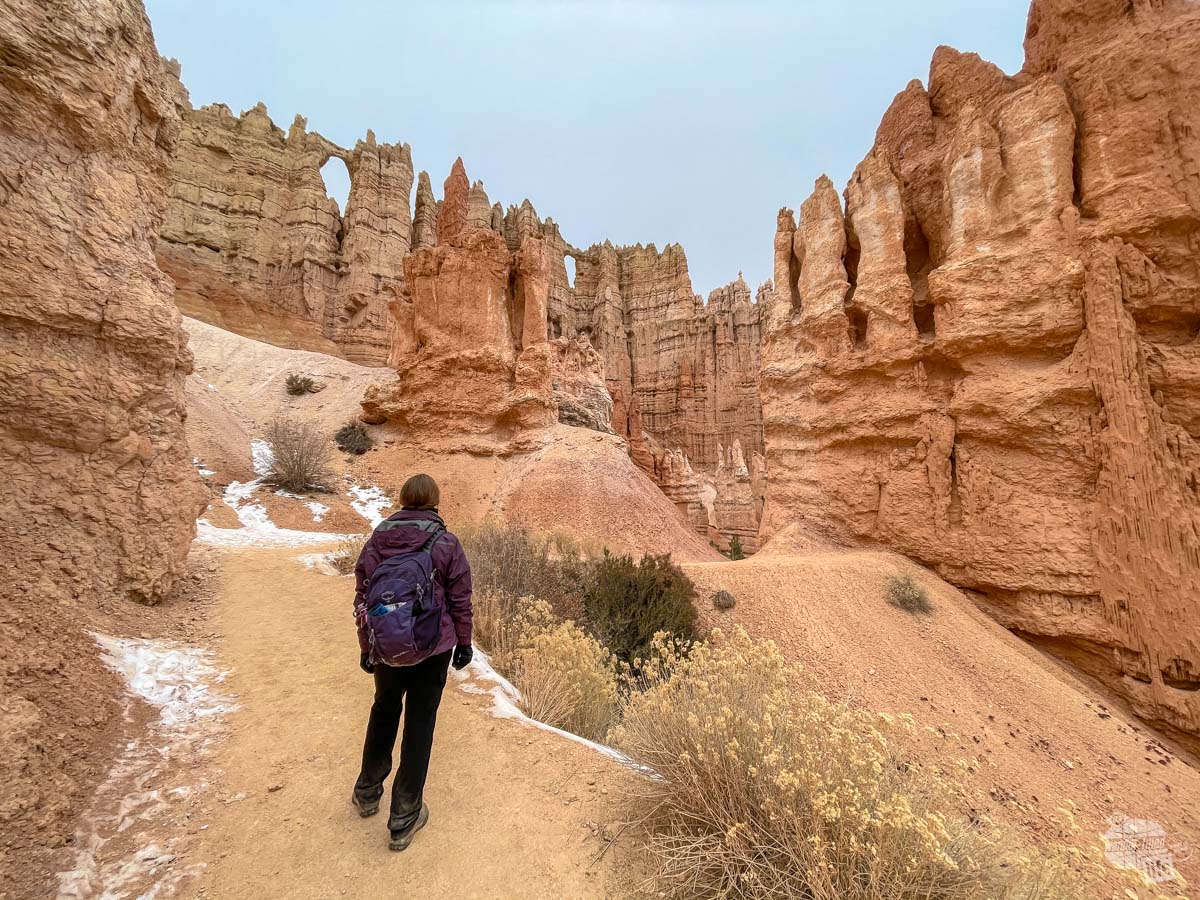
- Stormrepel DWR Plus | Stretch
- 2 Front Pockets | 2 Secure Zip Pockets
- Soft Plaid Fleece Lining
- Elastic Waistband with Functional Drawstring | Elastic Cuff Bottom
KUHL also sent us a pair of their Rydr pants for Bonnie to try out. They are great winter travel pants and good for sightseeing. Bonnie really likes how thick the pants are in terms of stopping the wind. All that said, they are cotton so won’t work well as hiking pants. But as an upgrade from wearing jeans in cold weather, they are great!
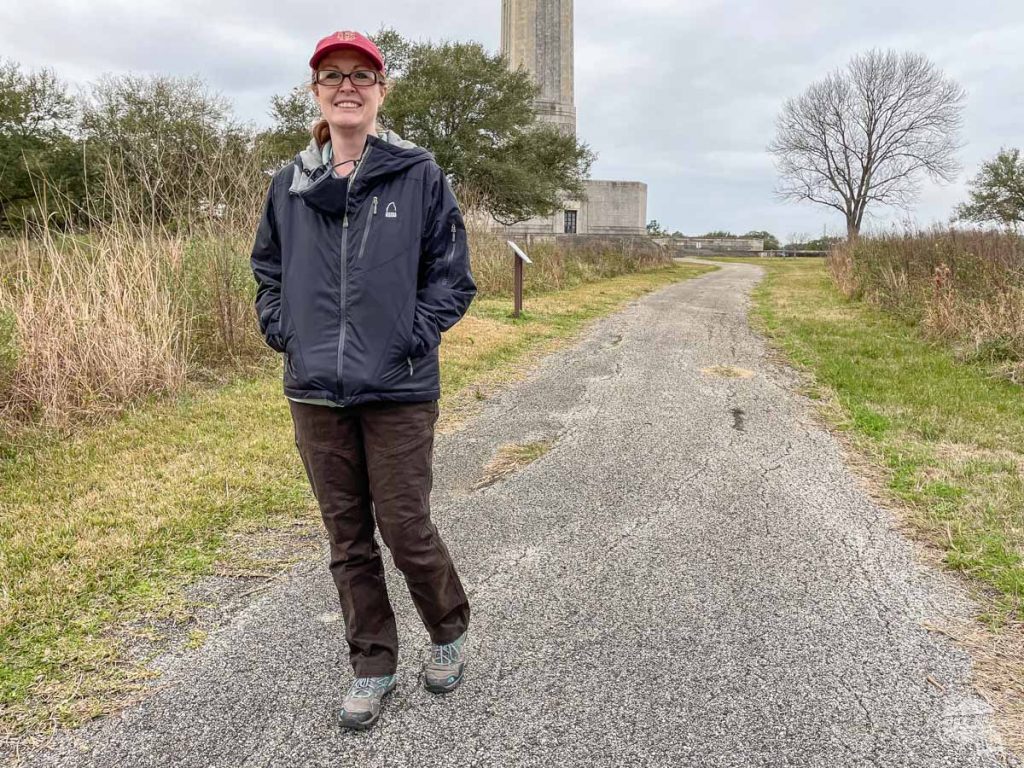
Hats, Gloves and Other Accessories
Like many of the products we list in here, we love Columbia’s Omni-Heat gear for a beanie. I have one of their lightweight beanies which I wear all the time and love. Bonnie has one of their heavier beanies which she loves.
I also have a Mountain Hardwear Dome Perignon which I wear when it’s very cold.
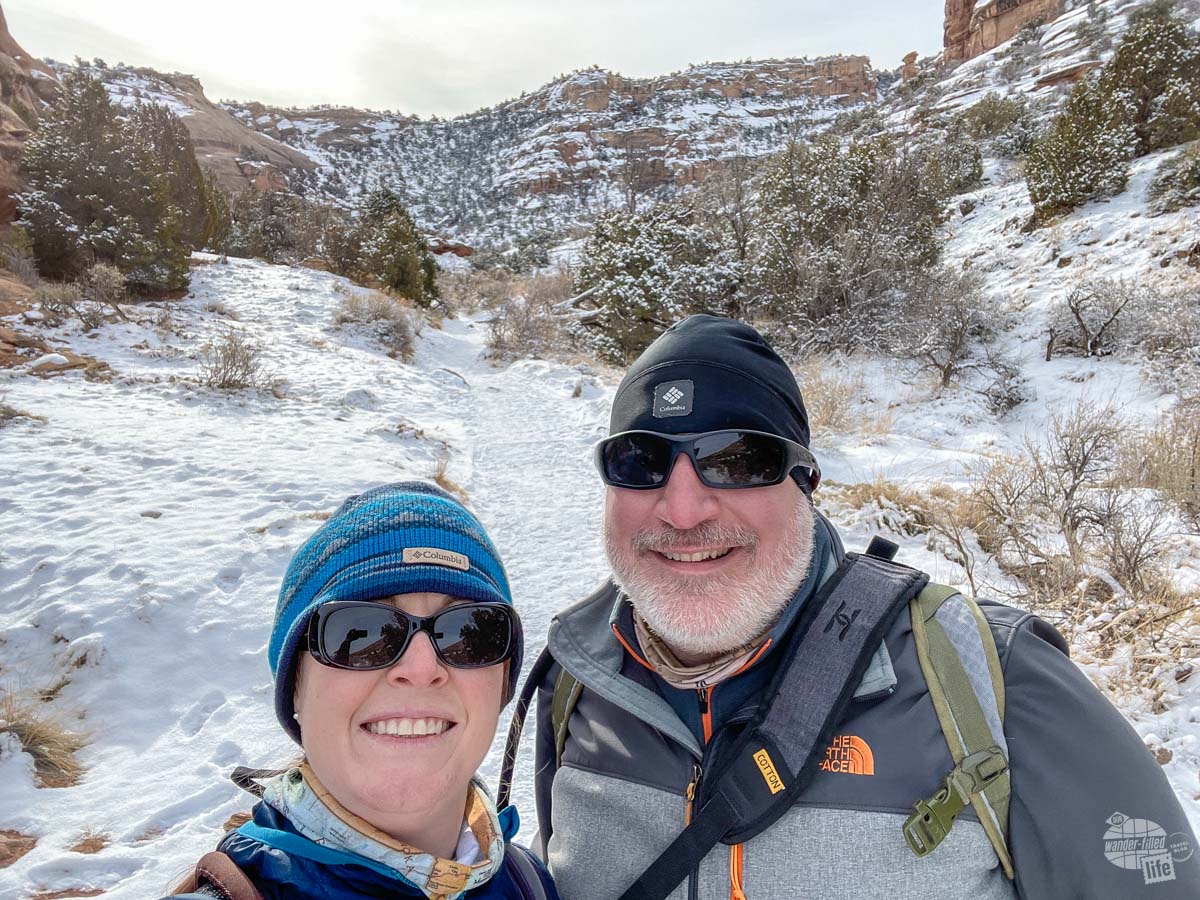
One thing I will say about headgear is bring something lighter with you just in case. When I was hiking in Bryce Canyon National Park, the Dome Perignon got way too warm and I had left my lighter Columbia beanie behind. I ended up using the Bana as a headband to keep the sweat out of my eyes.
Now, I take a moisture-wicking ball cap with me as well when I hike.
In terms of gloves, most of the time I wear the Omni-Heat glove liners from Columbia. These thin gloves work just fine for me. For Bonnie, they are a bit thin, so she wears their Omni-Heat fleece gloves. I have a pair as well and they do really well for colder temperatures.
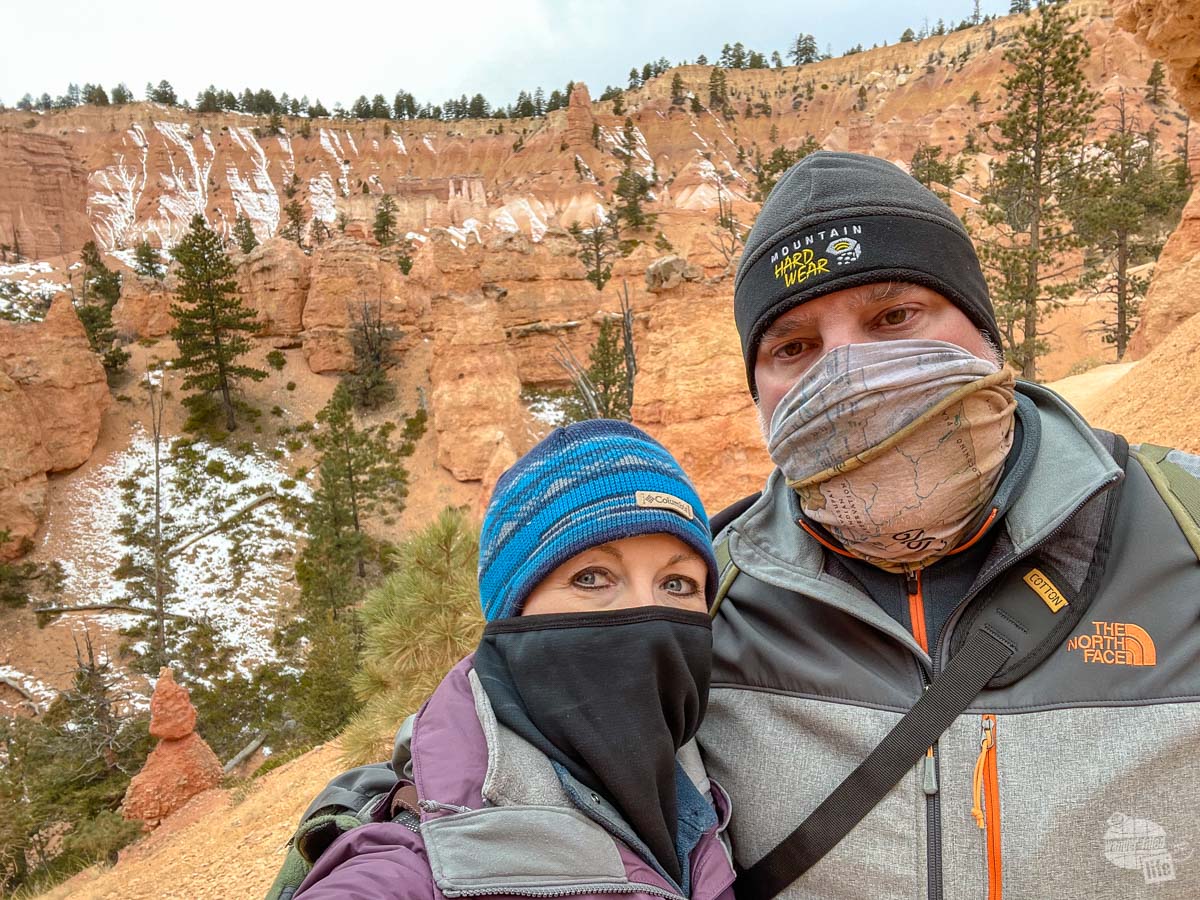
We both like the National Park topo map series from Bana. These light gaiters do a great job of keeping your face and neck reasonably warm. They aren’t great for super cold temperatures but they work like a champ when you need to keep that bitter wind off your face.
If you are hiking in serious cold, we recommend getting a heavier neck gaiter, like this one from Columbia, which uses the Omni Heat system. Did we mention we are big fans of the Omni Heat products?
- OMNI-HEAT: Our patented Heat Reflective lining is the ultimate heat management system for outdoor performance. The metallic dot patterned inner lining is designed to retain heat, while the breathable lining dissipates moisture
- EXTRA WARMTH: Get next-level warmth in this fleece neck gaiter with advanced thermal-reflective technology
- SHERPA SOFT: The Sherpa pile outer shell is supremely soft and enhances overall warmth
- STAY WARM: Inherently insulating for the whole body and easier to manage than a scarf, this stylish all-in-one gaiter works by holding the heat in around your neck, keeping you super warm on any outing
- STYLISH FLAIR: Available in a range of patterns and colors, a stylish gaiter can add a splash of fun and pop to any winter wardrobe. You better get two
Hiking Shoes and Socks
Hiking shoes are such a personal recommendation. What fits well for me might not fit well for you. I highly recommend you go to a store and try on various shoes to see how they fit. You will find some shoes just fit differently, even within a brand you are familiar with.
Personally, I wear Merrell Moab Hiking Shoes with Gore-Tex which I really like. Bonnie currently wears The North Face Hedgehog Fastpack GTX waterproof shoes.
The biggest thing is to get waterproof shoes. I can’t stress this enough. You do not want your feet to get wet when you are hiking in the winter.
- GORE-TEX waterproof membrane, exceptional breathability and waterproof performance
- Pig suede leather and breathable mesh upper
- 100% recycled laces and webbing
- Protective and abrasion resistant rubber heel and toe cap
- 100% recycled breathable mesh lining
- You’ll make up the mountain with dependable comfort in the reliable The North Face Hedgehog Fastpack II Waterproof shoes. Low-profile hiking shoes constructed in a waterproof PU-coated textile upper with a DryVent membrane.
- Rounded-toe construction features a lace-up closure, padded collar, and a breathable mesh lining. Designed with an ESS midfoot shank and a stable CRADLE cupped heel for additional comfort.
- Constructed with a single-density EVA footbed with an OrthoLite X35 hybrid technology.
- A durable rubber outsole features Vibram XS Trek for long-lasting protection.
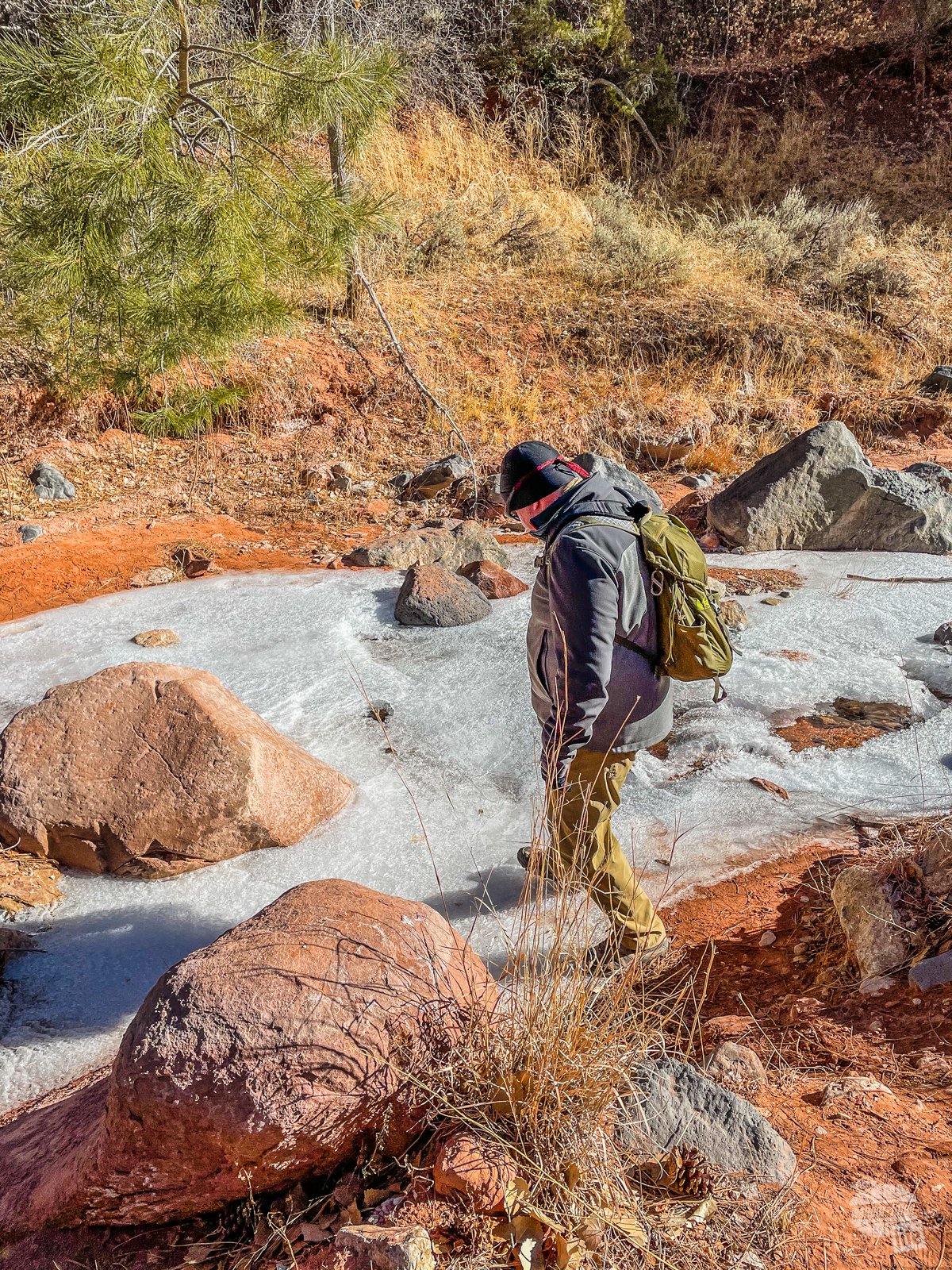
Recently, when I was hiking in Zion National Park, we were crossing a frozen creek and I stepped through the ice. My shoes had lasted several years and the waterproofing failed. Frigid water got in.
Fortunately for me, I was wearing SmartWool socks. These wool socks performed like champs. While my foot was wet for about 20 minutes of hiking, soon the socks wicked all of the moisture away from my feet and kept my foot warm. That is one of the biggest advantages of wool is it will continue to keep your feet warm even when wet.
I have worn these socks for 20 years and swear by them.
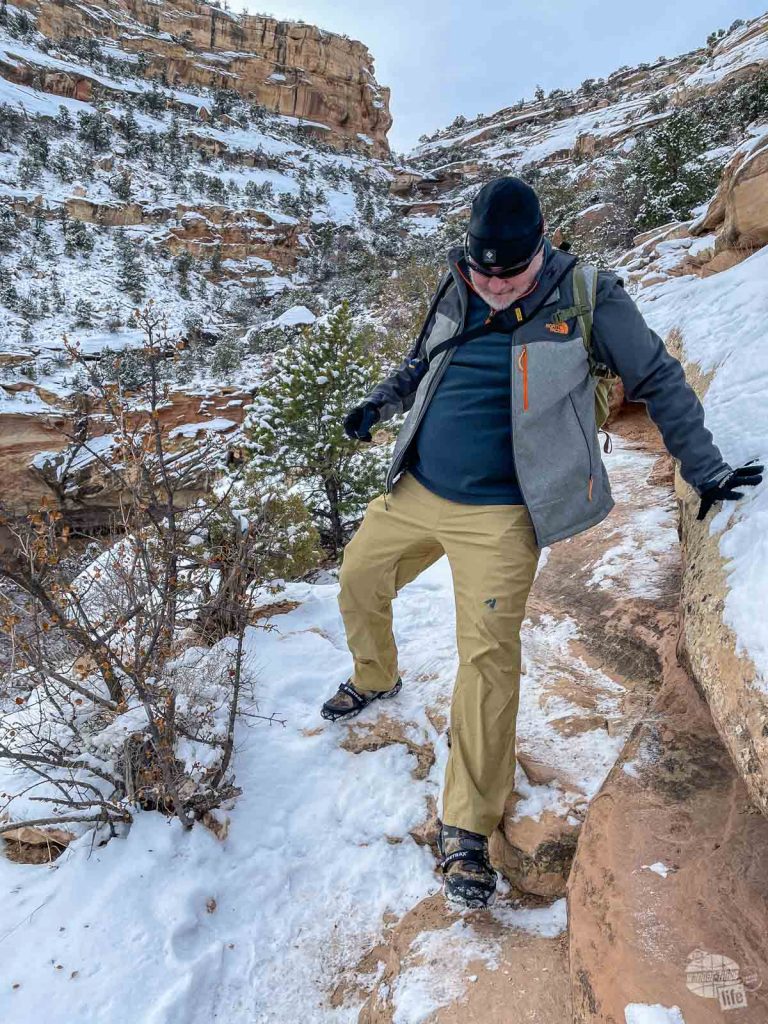
If you are going to be hiking in deeper snow or snowshoeing, getting a pair of gaiters will keep snow from getting into the top of your shoes.
One last thing to get for your feet: traction devices. Especially when hiking out in the desert in the winter, snow and ice can make for very slick conditions. So, we got some Yaktrax Pros to keep us from slipping.
Final Thoughts on Hiking in Cold Weather
Hiking in cold weather is actually a lot of fun. We really enjoy hiking in light snow and seeing the terrain covered in snow, especially in the Southwest. There is something truly magical about seeing the red rock desert dusted with snow. The contrast is simply amazing.
This is a big change for me. When I was in the Army, I hated being out in the snow. It was a truly miserable experience and I swore when I got out that I would never be willing to get out in the snow again.
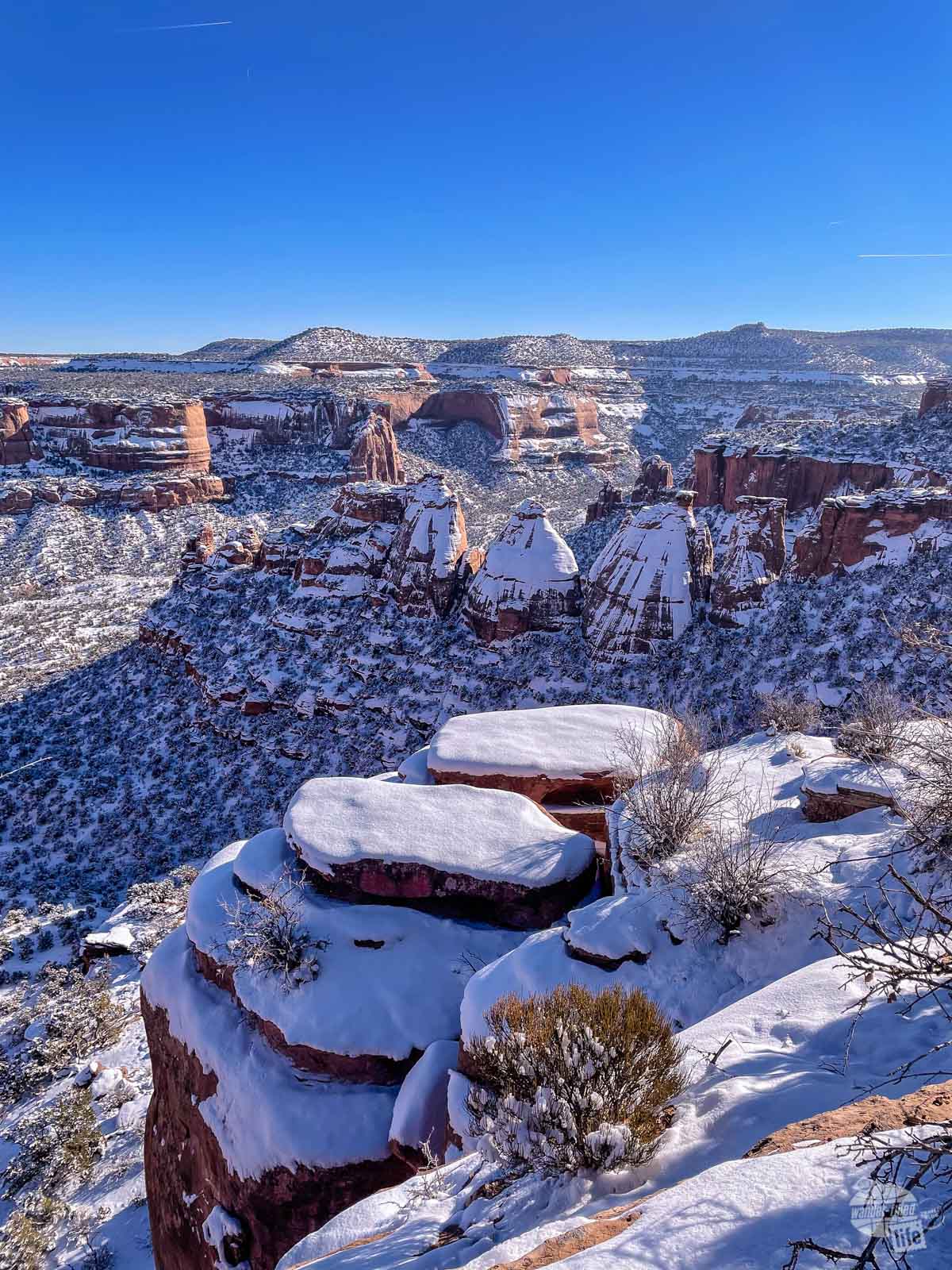
So, what changed? Well, Bonnie persuaded me to go snowmobiling in Yellowstone National Park and I bought a lot of gear for it and I discovered one inalienable truth: Having good gear for the cold makes all the difference.
I understand now how important good gear is when hiking in cold weather. It can take what would be otherwise miserable cold and turn it into an exhilarating experience.
We can’t recommend enough getting out on the trail even in the very cold temperatures. It is so worth it!
Travel Resources
What do you use to find a flight?
We use Skyscanner to find deals on flights. Skyscanner has a great interface and compares tons of airlines for the best pricing and routing. That said, it does not always have every airline and some airlines will have better deals on their website. Still, Skyscanner is a great place to start.
Click here to search for a flight.
What do you use to find a hotel?
We typically stay at Hilton properties, so we use the Hilton website. You can find good Hilton Honors discounts or AAA discounts for a hotel there. We make great use of our free night certificates from our Hilton Honors American Express.
Click here to book a Hilton property.
If there are no Hilton properties available, we use TripAdvisor to read reviews and book the hotel. We find we can get the best price that way.
Click here to search for a hotel.
We recently partnered with Stay22 to add interactive maps to each of our destination posts. This will allow you to see a plethora of hotels and vacation rentals all in one responsive map of the area.
What if I need more space than I can get at a hotel?
We use Vrbo for the times when we have rented a cabin for a weekend getaway, like this cabin in Townsend, TN, or needed to rent a house for a large family vacation. We had a great experience with them in terms of refunding deposits when COVID hit and will continue to use them.
Click here to search for a vacation rental.
Who do you use for rental cars?
As a general rule, we book with Hertz for rental cars. We have had nothing but good experiences with them. Plus, we really like unlimited mileage and not worrying about crossing state lines. We have even rented from Hertz overseas in both Slovenia and Croatia.
Click here to book a rental car.
How about booking a cruise?
We have found some amazing prices for booking a cruise through Cruise Direct. We have saved a lot of money on our cruises compared to what we found elsewhere, making a last-minute Bahamas cruise even cheaper.
Click here to book a cruise.
What if I want to rent an RV?
We highly recommend Outdoorsy for RV rentals. We rented a camper van for a week to visit Rocky Mountain National Park for the elk rut and Custer State Park for the Buffalo Round-Up and had a blast. The program was easy to use and we really enjoyed the freedom of having a camper van for that trip.
Click here to rent an RV.
What do you use for booking tours?
We don’t often book tours. Typically, we like to do stuff on our own. That said, there are some experiences you can’t have any other way. So, when we do want to book a tour, we always check Viator first.
Click here to book a tour.
Do you use anything to get discounts on the road?
We make extensive use of both Good Sam and AAA on the road. Good Sam is normally regarded as a discount card for RVers at campgrounds and Camping World but anyone can use the 5 cents off a gallon at the pump at both Pilot and Flying J.
Click here to get a Good Sam membership.
We have had AAA as long as we have been married and it has more than paid for itself in discounts at hotels, aside from the peace of mind of having roadside assistance. Add in paper maps and the ability to get an international driver’s license and it is more than worth it for any traveler out there.
Click here to get a AAA membership.
